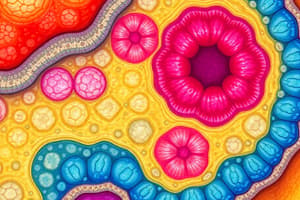Podcast
Questions and Answers
What is the main function of cartilage in the skeletal system?
What is the main function of cartilage in the skeletal system?
- Facilitating movements
- Generating heat
- Reducing friction during movement (correct)
- Providing physical stability
Which type of muscle tissue is responsible for facilitating digestion?
Which type of muscle tissue is responsible for facilitating digestion?
- Smooth muscle (correct)
- Striated (skeletal) muscles
- Adipose tissue
- Cardiac muscle
What is the main function of nervous tissue in multicellular organisms?
What is the main function of nervous tissue in multicellular organisms?
- Facilitating communication (correct)
- Generating heat
- Ensuring energy storage
- Maintaining normal functioning
Which type of muscle tissue is exclusively found in the heart wall?
Which type of muscle tissue is exclusively found in the heart wall?
What is the main function of adipose tissue in animals with backbones?
What is the main function of adipose tissue in animals with backbones?
Which class of muscle tissue is attached to bones?
Which class of muscle tissue is attached to bones?
What is the main function of epithelial tissue?
What is the main function of epithelial tissue?
Which of the following is NOT an example of connective tissue?
Which of the following is NOT an example of connective tissue?
What do tight and gap junctions do in epithelial tissue?
What do tight and gap junctions do in epithelial tissue?
Which type of connective tissue is composed primarily of collagen?
Which type of connective tissue is composed primarily of collagen?
What role does connective tissue play in living organisms?
What role does connective tissue play in living organisms?
Why are epithelial cells crucial in the gut?
Why are epithelial cells crucial in the gut?
Flashcards are hidden until you start studying
Study Notes
Exploring Tissues: A Fundamental Aspect of Living Organisms
If you've ever looked closely at a leaf under a magnifying glass, marveled at the intricate structure of your fingernail, or pondered how our hearts keep pumping blood—you're witnessing the complexity of tissues, which serve as the building blocks of life. In this exploration, we delve into various tissue types, each playing crucial roles in maintaining our body's intricate infrastructure.
Epithelial Tissue
Epithelial cells form sheets that cover internal and external surfaces of organs and protect them from their surroundings. They act like barriers against invasions while still allowing selective passage across these borders via specialized junctions between cells known as tight and gap junctions.
Examples:
- Skin forms a protective layer over our entire bodies.
- Lining the gut, epithelial cells segregate inner and outer environments by creating establishing a barrier against bacteria and pathogens while absorbing nutrients efficiently.
Connective Tissue
This complex and diverse group provides structural support, insulation, protection, and connectivity among different cellular components within living organisms. It encompasses loose fibrous connective tissue composed primarily of collagen; dense regular and irregular fibrous varieties containing thicker bundles of collagen fibers; and other specialized variants such as cartilage, bone, and adipose tissue.
Examples:
- Cartilage fills joint cavities in the skeletal system, reducing friction during movement.
- Bone constitutes the hard scaffold providing physical stability to animals with backbones.
- Adipose tissue serves multiple purposes including energy storage, thermal insulation, and endocrine functions.
Muscle Tissue
Muscles enable contraction and relaxation, facilitating movements, generating heat, and regulating posture through specialized proteins called myofibrils. Three main classes exist: striated (skeletal) muscles attached to bones, smooth muscle found within internal organs and blood vessels, and cardiac muscle present exclusively in the heart wall. All three exhibit distinct structures and capabilities.
Examples:
- Skeletal muscle scattered throughout our bodies control voluntary contractions enabling us to move freely.
- Smooth muscle lines internal organs and blood vessel walls; its contraction facilitates digestion and circulation processes respectively.
- Cardiac muscle enables the continuous pumping function of the heart leading to proper circulation of blood.
Nervous Tissue
Neurons, collectively forming nervous systems throughout multicellular organisms, facilitate communication within and between organisms by transmitting information rapidly and precisely as electrical signals and chemical messengers. Specialized glial cells coordinate neuron activities, ensure homeostasis, and maintain normal functioning.
Example:
The central nervous system (CNS), comprising brain and spinal cord, allows integration of sensory information to generate appropriate responses based on biological needs and environmental stimuli.
In summary, tissues offer a microscopic view of our world, showcasing the interplay of basic functional units responsible for sustaining complex life forms. Each type plays specific roles contributing significantly to overall physiological performance. By understanding these essential aspects of biology, we can better appreciate the wonders of human existence.
Studying That Suits You
Use AI to generate personalized quizzes and flashcards to suit your learning preferences.




